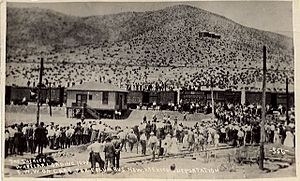Bisbee Deportation facts for kids
Quick facts for kids Bisbee Deportation |
|||
|---|---|---|---|

Striking miners and others being deported from Bisbee on the morning of July 12, 1917. The men are boarding the cattle cars provided by the El Paso and Southwestern Railroad.
|
|||
| Date | July 12, 1917 | ||
| Location | |||
| Goals | Union organizing | ||
| Methods | Strikes, protest, demonstrations | ||
| Resulted in | ~1,300 miners deported from Arizona | ||
| Parties to the civil conflict | |||
|
|||
| Lead figures | |||
|
|||
| Number | |||
|
|||
| Arrests, etc | |||
|
|||
The Bisbee Deportation was a major event in American labor history. On July 12, 1917, about 1,300 striking mine workers and their supporters were illegally rounded up. They were then forced out of Bisbee, Arizona. This action was carried out by a large group of about 2,000 men. These men were deputized, meaning they were given temporary police powers by the local sheriff.
The main company in the area, Phelps Dodge, planned this event. They even gave lists of people to arrest to the Cochise County sheriff, Harry C. Wheeler. The arrested people were first taken to a local baseball park. Then, they were forced onto cattle cars. These cars were usually used for animals. They were deported about 200 miles (320 km) away to Tres Hermanas in New Mexico.
This long journey through the desert lasted 16 hours. The people had no food and very little water. Once they arrived, most had no money or way to get home. They were warned not to return to Bisbee. The U.S. government later sent the U.S. Army to help move the deportees to Columbus, New Mexico.
Contents
What Caused the Deportation?
Miners Wanted Better Conditions
In 1917, miners in Bisbee were working hard. They dug for copper, which was very important. The United States was getting ready for World War I. Copper was needed for weapons and supplies. Miners wanted better pay and safer working conditions. They also wanted to join a union. Unions help workers bargain together for their rights.
The Strike Begins
Miners decided to go on strike. This meant they stopped working to protest. They hoped the mining companies would listen to their demands. However, the companies, especially Phelps Dodge, did not want to agree. They saw the strike as a threat. They worried it would slow down copper production.
The Day of the Deportation
The Roundup
On July 12, 1917, a large group of men gathered. These men were called a "posse." They were given special authority by Sheriff Harry C. Wheeler. They went through Bisbee, arresting anyone involved in the strike. They also arrested people who supported the miners. Even some regular citizens were caught up in the arrests.
Forced onto Trains
The arrested people were marched to a baseball park. From there, they were forced onto cattle cars. These trains were usually used to transport livestock. The journey was long and difficult. It took them across the desert to New Mexico. The people had no food and little water.
After the Deportation
News Spreads Slowly
Phelps Dodge and the sheriff tried to keep the event a secret. They cut off communication with the outside world. This made it hard for the story to get out. Eventually, news of the deportation reached the public. The company tried to say their actions helped the war effort. They claimed the strikers were hurting the country.
Government Steps In
The Governor of New Mexico learned about the deportees. He worked with President Woodrow Wilson. They provided temporary homes for the people. President Wilson then sent a special group to investigate. This group was called a presidential mediation commission.
The Investigation's Findings
In November 1917, the commission released its report. They said the deportation was "wholly illegal." This meant it was against the law. They stated that no one had the authority to do what happened.
No One Was Punished
Even though the deportation was called illegal, no one was ever punished. Neither Arizona nor Cochise County took legal action. Later, the Supreme Court looked at a case about the event. In United States v. Wheeler (1920), the Court decided something important. It ruled that the U.S. Constitution does not give the federal government power to stop kidnappings. This was true even if people were moved across state lines on trains.
The Bisbee Deportation remains a significant event. It shows a time when companies had great power. It also highlights the struggles of workers to gain fair treatment.

